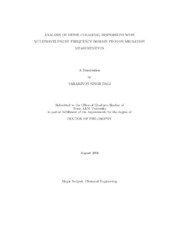| dc.contributor.advisor | Sevick-Muraca, Eva M. | |
| dc.creator | Dali, Sarabjyot Singh | |
| dc.date.accessioned | 2010-01-15T00:14:42Z | |
| dc.date.accessioned | 2010-01-16T02:07:35Z | |
| dc.date.available | 2010-01-15T00:14:42Z | |
| dc.date.available | 2010-01-16T02:07:35Z | |
| dc.date.created | 2006-08 | |
| dc.date.issued | 2009-06-02 | |
| dc.identifier.uri | https://hdl.handle.net/1969.1/ETD-TAMU-1751 | |
| dc.description.abstract | Frequency domain photon migration (FDPM) measurements are used to study
the properties of dense colloidal dispersions with hard sphere and electrostatic interactions,
which are otherwise difficult to analyze due to multiple scattering effects.
Hard sphere interactions were studied using a theoretical model based upon a
polydisperse mixture of particles using the hard sphere Percus Yevick theory. The
particle size distribution and volume fraction were recovered by solving a non linear
inverse problem using genetic algorithms. The mean sizes of the particles of 144
and 223 nm diameter were recovered within an error range of 0-15.53% of the mean
diameters determined from dynamic light scattering measurements. The volume fraction
was recovered within an error range of 0-24% of the experimentally determined
volume fractions.
At ionic strengths varying between 0.5 and 4 mM, multiple wavelength (660, 685,
785 and 828 nm) FDPM measurements of isotropic scattering coefficients were made
of 144 and 223 nm diameter, monodisperse dispersions varying between 15% - 22%
volume fraction, as well as of bidisperse mixtures of 144 and 223 nm diameter latex
particles in 1:3, 1:1 and 3:1 mixtures varying between volume fractions of 15% - 24%.
Structure factor models with Yukawa potential were computed by Monte Carlo (MC)
simulations and numerical solution of the coupled Ornstein Zernike equations.
In monodisperse dispersions of particle diameter 144 nm the isotropic scattering coefficient versus ionic strength show an increase with increasing ionic strength consistent
with model predictions, whereas there was a reversal of trends and fluctuations
for the particle diameter of 223 nm.
In bidisperse mixtures for the case of maximum number of smaller particles,
the isotropic scattering coefficient increased with increasing ionic strength and the
trends were in conformity with MC simulations of binary Yukawa potential models.
As the number of larger diameter particles increased in the dispersions, the isotropic
scattering coefficients depicted fluctuations, and no match was found between the
models and measurements for a number ratio of 1:3.
The research lays the foundation for the determination of particle size distribution,
volume fractions and an estimate of effective charge for high density of particles. | en |
| dc.format.medium | electronic | en |
| dc.format.mimetype | application/pdf | |
| dc.language.iso | en_US | |
| dc.subject | multiple scattering | en |
| dc.subject | frequency domain photon migration | en |
| dc.subject | genetic algorithms | en |
| dc.subject | monte carlo simulations | en |
| dc.subject | ornstein zernike equations | en |
| dc.subject | yukawa potential | en |
| dc.subject | global optimization | en |
| dc.subject | particle size distribution | en |
| dc.title | Analysis of dense colloidal dispersions with multiwavelength frequency domain photon migration measurements | en |
| dc.type | Book | en |
| dc.type | Thesis | en |
| thesis.degree.department | Chemical Engineering | en |
| thesis.degree.discipline | Chemical Engineering | en |
| thesis.degree.grantor | Texas A&M University | en |
| thesis.degree.name | Doctor of Philosophy | en |
| thesis.degree.level | Doctoral | en |
| dc.contributor.committeeMember | Bevan, Michael A. | |
| dc.contributor.committeeMember | Ford, David M. | |
| dc.contributor.committeeMember | Wang, Lihong | |
| dc.type.genre | Electronic Dissertation | en |
| dc.type.material | text | en |
| dc.format.digitalOrigin | born digital | en |


